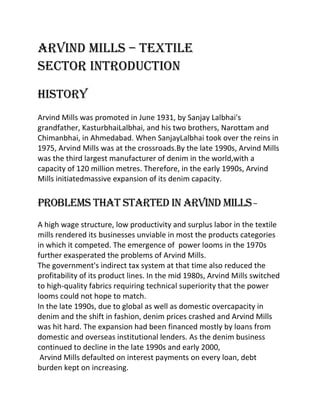
Arind mills case study
- 1. ARVIND MILLS – TEXTILE SECTOR INTRODUCTION History Arvind Mills was promoted in June 1931, by Sanjay Lalbhai's grandfather, KasturbhaiLalbhai, and his two brothers, Narottam and Chimanbhai, in Ahmedabad. When SanjayLalbhai took over the reins in 1975, Arvind Mills was at the crossroads.By the late 1990s, Arvind Mills was the third largest manufacturer of denim in the world,with a capacity of 120 million metres. Therefore, in the early 1990s, Arvind Mills initiatedmassive expansion of its denim capacity. Problems that started in Arvind Mills – A high wage structure, low productivity and surplus labor in the textile mills rendered its businesses unviable in most the products categories in which it competed. The emergence of power looms in the 1970s further exasperated the problems of Arvind Mills. The government's indirect tax system at that time also reduced the profitability of its product lines. In the mid 1980s, Arvind Mills switched to high-quality fabrics requiring technical superiority that the power looms could not hope to match. In the late 1990s, due to global as well as domestic overcapacity in denim and the shift in fashion, denim prices crashed and Arvind Mills was hit hard. The expansion had been financed mostly by loans from domestic and overseas institutional lenders. As the denim business continued to decline in the late 1990s and early 2000, Arvind Mills defaulted on interest payments on every loan, debt burden kept on increasing.
- 2. In 2000, the company had a total debt of Rs 27 billion, of which 9.29 billion was owed to overseas lenders. Arvind Mills' expansion strategy resulted in the company's poor financial health in the late1990s. In the mid 1990s, Arvind Mills' undertook a massive expansion of its denim capacity in spite of the fact that other cotton fabrics were slowly replacing the demand for denim .The expansion plan was funded by loans from both Indian and overseas financial institutions. With the demand for denim slowing down, Arvind Mills found it difficult to repay the loans, and thus the interest burden on the loans shot up. In the late 1990s, Arvind Mills ran into deep financial problems because of its debt burden. As a result, it incurred huge losses in the late1990s. The company's credit rating had also come down. CRISIL downgraded it to "default"in October 2000 from "highest safety" in 1997. Strategy In early 2001, Arvind Mills announced a restructuring proposal to improve its financial health and reduce its debt burden. The proposal was born out of several meetings and negotiations between the company and a steering committee of lenders. Steps taken - Then Arvind Mills went for debt-restructuring plan for the long-term debts.The restructuring was overseen by Mr Jayesh Shah, CFO and advised on by a JP MorganHong Kong team, led by Mr Ahmad Ayaz . New markets were created, technology was upgraded, and looking at rationalising their suppliers and competition was also tackled.In 2003 - For the fourth quarter, Arvind Mills witnesses 280% growth in the net profitArvind Mills Ltd is assigned a `P1+` rating by CRISIL, which indicates a very strong ratingfor their commercial paper.In 2004 -
- 3. Company turns itself around showing remarkable improvement in financial performance. This was done only when all the parts of the organisation started back to be insync. The decisions were taken accordingly so that every activity in the organisation area ligned. It was necessary to do so as they don’t face the same problem that they have faced earlier of non-repayment of loans which they had taken for capacity expansion.In 2005 - For the fourth quarter in a row, Arvind Mills has managed to post a profit growth in excess of 80 per cent .History has been witness to the Arvind Group’s commitment to excellence, innovation, perseverance and undying attention to customer and societal needs. As an organization,Arvind has successfully integrated diverse businesses, services and products, unified by a common vision - of enriching lifestyles.Policy of change has fetched the company to well deserved results . Arvind Mills’s adoptionof new-age fabrics has seen the Company emerge as one of the largest denim manufacturers in the world, while also bringing us global recognition for the manufacture of shirting, khakhi and knitted fabrics.Currently Arvind Mills has a strong Research and Development focus on process improvement, cost reduction and new product development. Arvind Mills continuously modifies its production process to enhance flexibility on the use of various types and quality of cotton. To further meet customer needs, Arvind Mills has also introduced a new dyeing and processing method for denims.State-of-the-art technology and equipment have made Arvind Mills one of the top three producers of denim in the world, paving the way for the Company to emerge as a global textile conglomerate. This cutting edge position comes to Arvind Mills courtesy technologies such as Open-end Spinning, Foam Finishing,
- 4. Mercerizing, Slasher-dyeing, Rope-dyeing, Air-Jet, Projectile and Wet Finishing. It’s only natural that Arvind Mills’s quality fabrics are inhigh demand in the markets of Europe, US, West Asia, the Far East and Asia Pacific.